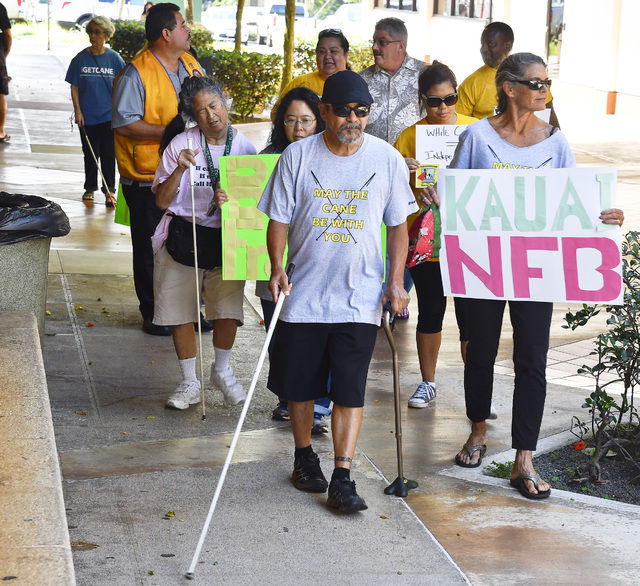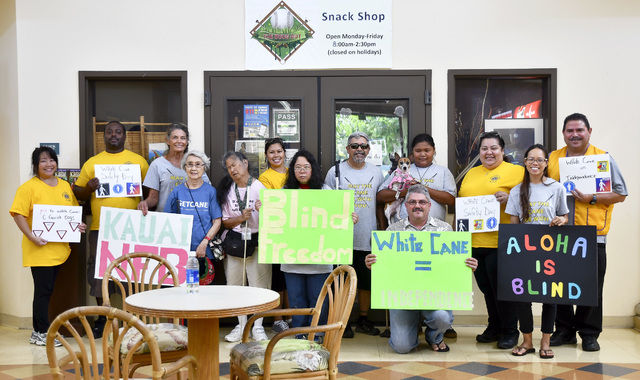LIHUE — While there are lights on the crosswalk fronting the Lihue Post Office, that’s no help to blind people who cannot see them, said Douglas Peneyra, the blind operator of a snack shop in the Pi‘ikoi Building. “That is
LIHUE — While there are lights on the crosswalk fronting the Lihue Post Office, that’s no help to blind people who cannot see them, said Douglas Peneyra, the blind operator of a snack shop in the Pi‘ikoi Building.
“That is a dangerous crosswalk,” Peneyra said. “There are two crosswalks by Central Pacific Bank that have the audio signals, but people prefer to use this crosswalk. The addition of audio signals would make this safer for the blind.”
Peneyra was joined Thursday by his daughter Grayling and Honi, the family’s pet dog, in leading a handful of people, including several blind people and members of the East Kauai and Kauai Lions clubs, for the White Cane Safety Day walk. The group walked from the state building, along Eiwa and Rice streets, to end at Peneyra’s shop.
“There are about 2,700 people in the Hawaii blind registry,” Peneyra said. “I don’t know how many are on Kauai, but there are a lot. And it does not count the people who are legally blind, but are not on the registry.”
Mel Rapozo, participating as a member of the Kauai Lions Club, said he was glad he took time to join the walk.
“As the council chair, I’m glad I got to see the conditions on Eiwa Street,” Rapozo said. “It is important to improve these roads for the blind community. They do little complaining, but I got to see the bumps and obstacles they need to deal with.”
Peneyra said he became blind as a result of an auto accident in 2006.
“I was in a coma,” he said. “The lack of blood flow burned my optic nerve. Before the accident, I was a carpenter for 33 years. During my recovery, I was inspired by the Ho‘opono program with the Division of Vocational Rehabilitation. They had a wood shop equipped with regular equipment that we had to learn how to use. They also taught us sewing — I learned three different ways to thread a needle — and they taught us cooking from scratch. We had to make all kinds of dishes and desserts — all from scratch.”
As he neared the end of his Ho‘opono training on Oahu, the DVR asked if he was interested in being a blind vendor, operating a convenience store on Kauai.
“I was definitely interested,” Peneyra said. “But that meant more time on Oahu for further training. I wanted to come home, but agreed to the training. During that time, they made me an instructor at Ho‘opono where I met this Hawaiian lady who learned how to create things with wood — bracelets, canoe paddles, and a lot of other wood items. All of this was truly inspirational.”
Debbi Thompson, employment specialist with DVR, said one of the biggest obstacles blind people face is stereotyping.
“The Ho‘opono program, modelled after a Mainland program and fine-tuned for Hawaii, is one of the finest programs in the nation,” Thompson said. “It demonstrates that the blind can be very independent and can do about anything a normal person can do. There are blind people in many professions, and being visually impaired does not mean you lose your independence.”
Peneyra said the white cane symbolizes independence for the blind and visually impaired.
“The White Cane Day was started by President Lyndon Johnson in 1964 with the signing of the Blind Americans Equality Day proclamation on Oct. 15,” Peneyra said. “In Hawaii, we are celebrating our 24th year. We want to educate people about blindness and how the blind and visually impaired can live and work independently while giving back to the community. White Cane Day also celebrates the abilities and successes achieved by blind people in a sighted world, and to honor the many contributions being made by the blind and visually impaired. We want more people walking next year.”
Peneyra, who leads the National Federation for the Blind, Kauai Chapter, said he always walks to the state building where the monthly meetings are held.
“If I don’t hear the car, I just go,” Peneyra said. “A lot of people are helpful, but I like the challenge. I just do it.”




